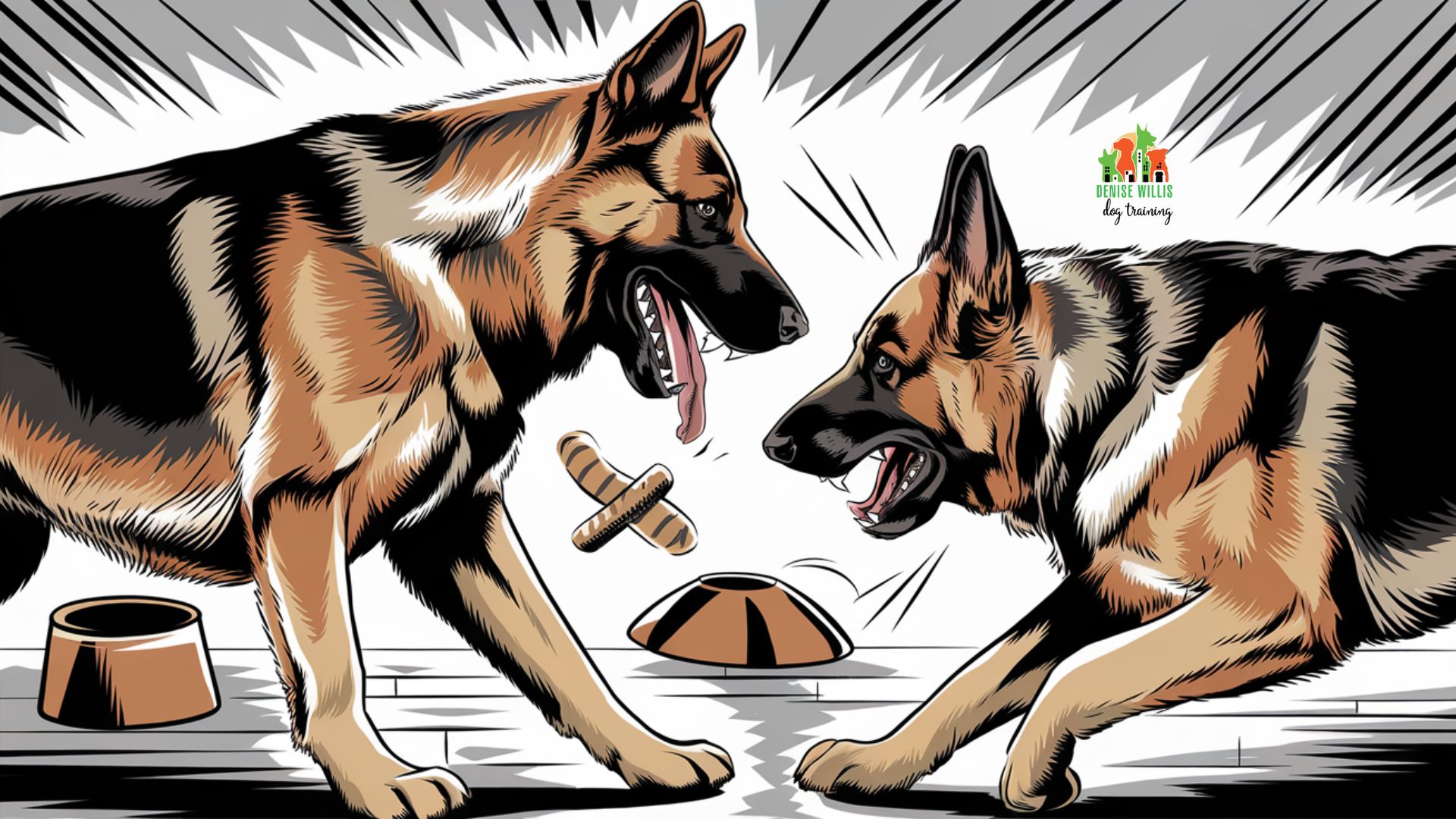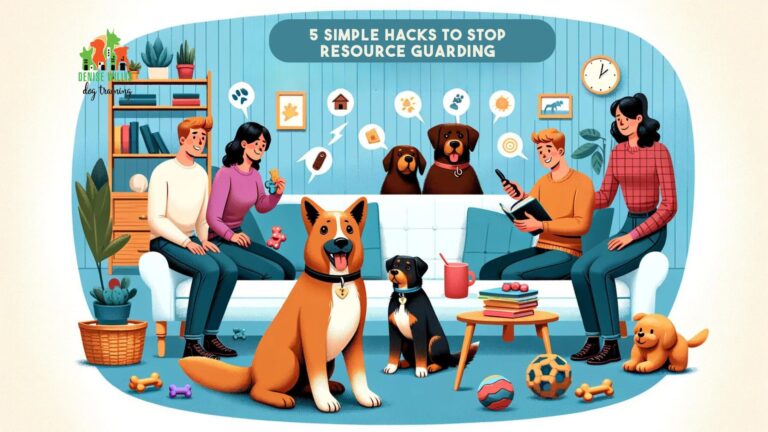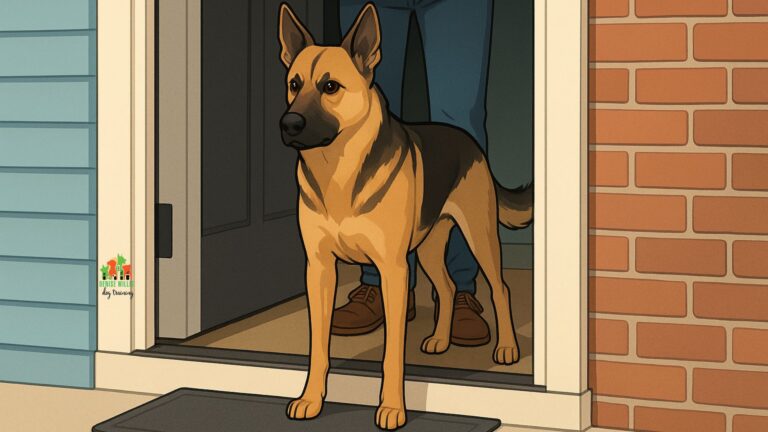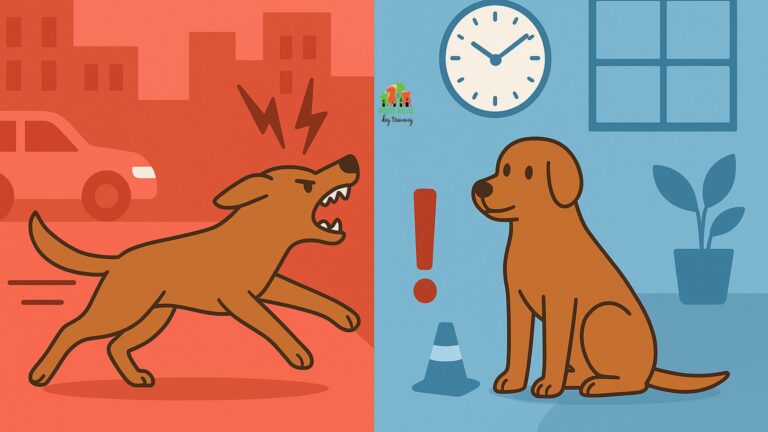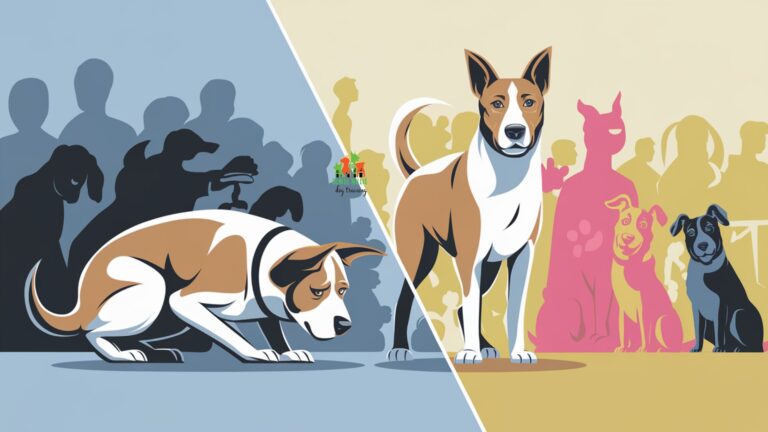Battle of the Sexes: Dealing with Same-Sex Aggression in Dogs
📍 Service Area Notice: DW Dog Training provides in-person training services exclusively in the Greater Baltimore area. While our blog content is designed to help dog owners internationally, our hands-on training services are locally focused. For readers outside our service area, we hope you find value in our articles and welcome you to reach out with questions!
Ever caught your dogs giving each other the canine equivalent of a death stare?
Same-sex aggression in dogs can turn your peaceful home into a furry battleground faster than you can say “Down, Fido!” It’s a perplexing issue that leaves many dog owners scratching their heads and wondering if they’ve stumbled into a doggy soap opera.
But fear not.
While it might feel like you’re refereeing a never-ending sibling rivalry, understanding and managing same-sex aggression is possible. From the sweet Labrador who suddenly can’t stand her sister to the terrier who thinks he’s the toughest guy on the block, this behavior can affect any breed and any household.
So, whether you’re dealing with canine catfights or doggy disputes, it’s time to dig into the root of the problem and find some tail-wagging solutions. Ready to transform your home from a doggy drama stage back to a peaceful pet paradise?
Let’s unleash the secrets to handling same-sex aggression and get your furry family back on speaking terms!
Key Takeaways
- Same-sex aggression often emerges as dogs reach social maturity, typically between 18-36 months old
- Female-female aggression tends to be more severe than male-male conflicts
- Early socialization and proper introductions are crucial in preventing SSA
- Environmental management and behavior modification are key strategies for managing existing SSA
- Professional help may be necessary for severe cases or when DIY methods aren’t effective
Understanding Same-Sex Aggression in Dogs
The mysterious world of canine social dynamics. It’s like high school, but with more fur and less homework. Same-sex aggression (SSA) in dogs isn’t just about who gets the comfiest spot on the couch; it’s a complex interplay of instincts, hormones, and good old-fashioned rivalry.
Root Causes: It’s Not You, It’s Them (Mostly)
From an evolutionary standpoint, our furry friends are still catching up with the whole “domesticated” thing. In the wild, same-sex individuals often compete for breeding rights and resources. Your living room might not be the Serengeti, but try telling that to Fido and Rex.
Hormones play a significant role too. Testosterone in males can turn your sweet boy into a canine Hulk, while estrogen fluctuations in females can lead to mood swings that would put any teenage drama to shame. And let’s not forget about stress hormones like cortisol, which can make everyone a bit more… let’s say, “touchy.”
Prevalence and Risk Factors: The Numbers Game
Here’s a fun fact that’s not actually fun: a study found that 79% of inter-dog household aggression cases involved same-sex pairs. And if you think the girls are sugar and spice and everything nice, think again. 68% of those pairs were females.
It’s like “Mean Girls,” but with more growling and less pink.
Risk factors include:
- Same-sex pairing (duh)
- Age difference (the youngster often starts it)
- Recent addition to the household (new kid on the block syndrome)
- Intact status (those hormones are no joke)
Boys vs. Girls: Battle of the Sexes
While both sexes can exhibit SSA, there are some differences:
- Female-female aggression is often considered more severe and damaging. It’s like they’re auditioning for “The Real Housedogs of Beverly Hills.”
- Male-male aggression tends to involve more posturing and less injury. Think of it as a canine rap battle.
- Spaying has little effect on female SSA, while neutering can help reduce male SSA. Sorry, ladies, but the boys have an easier fix here.

Breeds Prone to SSA: The Usual Suspects
While any dog can develop SSA, some breeds seem to have a particular talent for it. It’s like they’re auditioning for a reality TV show about dramatic canines.
- Alaskan Malamutes (the divas of the dog world)
- Dobermans (those pointy ears are perfect for eavesdropping on gossip)
- Terrier breeds (small dogs with big attitudes)
- Boxers (always ready for a boxing match)
- American Pit Bull Terriers (they take the “pit” in their name a bit too literally)
- German Shepherds (they shepherd chaos as well as sheep)
- Rottweilers (they’re not all bark and no bite)
Remember, though, that breed is just one factor. Your Chihuahua and Great Dane could be best buds, while two Labs might decide they’re mortal enemies. Dogs are individuals, after all, with their own unique… quirks.
Recognizing the Signs of SSA: Reading the Doggy Tea Leaves
Spotting SSA early can save you a lot of headaches (and potential vet bills). Here are some signs your dogs might be auditioning for “West Side Story”:
- Intense staring or “hard looks” (the canine equivalent of “You talkin’ to me?”)
- Growling, snarling, or snapping when the other dog approaches
- Blocking access to resources or preferred areas (doggy territorialism at its finest)
- Mounting behavior (in both males and females – it’s a dominance thing)
- Sudden tension when the dogs are in close proximity (you could cut it with a knife… or a chew toy)
Triggers and Causes: What Sets Off the Furry Fireworks?
SSA can be triggered by various factors:
- Competition for resources (food, toys, your attention – basically, everything)
- Excitement or arousal (sometimes play can turn into a WWE match)
- Fear or pain (nobody likes to be vulnerable around their rival)
- Hierarchy instability (who’s the top dog? It’s complicated)
- Confined spaces (nobody likes a close talker, especially not dogs)
- Owner proximity (fighting over the favorite human)
But don’t just take my word for it. Let’s look at some hair-raising stats that’ll show you just how common this doggy drama really is!
The Numbers Don’t Lie: Same-Sex Aggression Stats That’ll Make Your Tail Spin
Alright, we’re about to dive into the nitty-gritty world of canine same-sex aggression statistics. Now, I know what you’re thinking – “Numbers? Yawn!” But trust me, these stats are juicier than the steak your pup’s been eyeing all night. They’ll give you a real bone to chew on when it comes to understanding just how common and complex this furry phenomenon is.
| Statistic | Percentage | Notes | Source |
|---|---|---|---|
| Same-sex pairs in aggression cases | 79% | Of inter-dog household aggression cases | [1] |
| Female-female aggression pairs | 68% | Of same-sex aggression pairs | [1] |
| Aggression instigated by younger/newer dog | 70% | Of same-sex aggression cases | [1] |
| Pairs with at least one female dog | 70% | In a study of 305 pairs with intrahousehold aggression | [3] |
| Same-sex pairs in aggression study | 61.6% | In a study of 305 pairs with intrahousehold aggression | [3] |
| Resource guarding as fight trigger | 72.8% | Most common trigger in aggression cases | [3] |
| Possessive aggression comorbidity | 35.4% | Most common comorbidity for individual dogs | [3] |
| Aggressor acquired after recipient | 59.3% | In pairs with intrahousehold aggression | [3] |
Those numbers are enough to make any dog owner’s ears perk up, right? Who knew our furry friends were such drama queens (and kings)? But remember, folks, these stats aren’t here to scare you. They’re here to arm you with knowledge. Because knowing is half the battle when it comes to managing same-sex aggression in your pack.
So, the next time you see your pooches giving each other the stink eye, just remember – you’re not alone in this doggy soap opera. Millions of pet parents are right there with you, trying to referee these canine conflicts. And armed with these stats, you’re already ahead of the game! Now that we’ve seen just how widespread this issue is, let’s dig into how we can keep the peace in our own furry households.
Same-Sex Aggression in Dogs: Key Facts
Prevalence
79% of inter-dog household aggression cases involve same-sex pairs, with 68% being female-female.
Triggers
Resource guarding is the most common fight trigger, occurring in 72.8% of cases.
Age Factor
Over 70% of the time, aggression is instigated by the younger dog of the pair or the newer addition to the household.
Risk Factors
Same-sex pairs, history of skin-breaking bites, and aggression on sight are associated with poor outcomes.
Prevention Strategies: An Ounce of Prevention is Worth a Pound of Dog Treats
Preventing SSA is like trying to stop a food fight before the first spaghetti strand flies. It requires foresight, quick reflexes, and possibly a hazmat suit. Here are some tips:
- Early socialization: Expose your puppy to various dogs, people, and situations. Think of it as sending your dog to finishing school, minus the fancy hats.
- Proper introductions: When adding a new dog to your pack, consider opposite-sex pairings. It’s like arranging a blind date, but with more sniffing and less awkward small talk.
- Neutering/spaying considerations: While not a magic bullet, it can help reduce aggression, especially in males. It’s like putting your dog on a hormone-free diet.
- Training and behavior modification: Reinforce good behaviors and interrupt the bad ones. It’s like being a referee in a very furry, very unpredictable sports match.
- Environmental management: Control access to resources and manage potential triggers. Basically, become the bouncer of your own home.
Timeline of Same-Sex Aggression in Dogs
3-16 weeks of age
Critical developmental period for puppy socialization. Early socialization during this time is crucial in preventing future same-sex aggression.
6-9 months of age
Sexual maturity in dogs. However, this is not directly associated with the onset of inter-dog aggression. Continued socialization and training are important during this stage.
18-36 months of age
Social maturity in dogs. This is the most common age range for the onset of same-sex aggression. Inter-dog aggression often becomes apparent during this period. Extra vigilance and management may be needed.
3-4 years of age
Dogs have typically passed social maturity, allowing for better evaluation of their true temperament. Same-sex aggression patterns may be well-established by this point.
Ongoing management
Same-sex aggression requires lifelong attention and adherence to management strategies. Consistent training, controlled environments, and professional help when needed are key to managing this behavior long-term.
Management Techniques for Existing SSA: When Prevention Ship Has Sailed
So, your dogs have already decided they’re mortal enemies. Don’t worry, all is not lost! Here are some strategies to restore peace:
- Separation strategies: Keep the feuding parties apart when you can’t supervise. It’s like putting siblings in separate rooms when they can’t stop bickering.
- Environmental management: Ensure there are enough toys, beds, and attention to go around. It’s like being Santa Claus, but all year round.
- Behavior modification protocols: This might include desensitization and counterconditioning. It’s like couples therapy for dogs, minus the couch and clipboard.
- Professional intervention: Sometimes, you need to call in the big guns. A professional dog trainer or behaviorist can be your furry family’s therapist.
Remember, managing SSA is a marathon, not a sprint. It requires patience, consistency, and possibly a sense of humor. After all, if you can’t laugh at the absurdity of your dogs giving each other the silent treatment, what can you laugh at?
Real-Life Scenarios: Managing SSA in Common Situations
Living with dogs who can’t stand each other is like being stuck in a never-ending episode of a canine reality show. Let’s dive into some real-world strategies to keep the peace in your furry household.
At Home: Strategies for Peaceful Coexistence
Living with dogs experiencing SSA can feel like navigating a minefield. Here are some tips:
- Establish separate feeding areas and times
- Rotate access to favorite spots or toys
- Use baby gates or crates for management when needed
- Provide individual attention and training sessions
On Walks: Dealing with SSA Outside the Home
Walking multiple dogs with SSA can be like juggling flaming torches while riding a unicycle. Try these strategies:
- Walk dogs separately if necessary
- Use proper equipment (harnesses, head halters) for better control
- Practice obedience skills in low-distraction environments first
- Be aware of your surroundings and potential triggers
Introducing a New Dog: Steps to Prevent SSA from Developing
Bringing a new dog into the mix? Here’s how to start on the right paw:
- Choose a neutral location for introductions
- Keep initial meetings short and positive
- Monitor body language closely
- Gradually increase interaction time
The Emotional Toll: Supporting Owners Through SSA Challenges
Dealing with doggy drama isn’t just tough on our four-legged friends. It can leave pet parents feeling like they’re trapped in an emotional tug-of-war. Let’s talk about keeping your sanity while managing the canine chaos.
Coping with Stress and Guilt
Dealing with SSA can be emotionally draining. Remember:
- It’s not your fault
- Progress may be slow, but it’s possible
- Self-care is crucial for both you and your dogs
When to Consider Rehoming: Making Tough Decisions
Sometimes, despite our best efforts, rehoming might be the safest option. Consider it if:
- There’s a risk of serious injury to dogs or humans
- Quality of life for all involved is significantly impacted
- Professional interventions haven’t yielded results
Building a Support Network
You’re not alone in this journey. Seek support from:
- Other dog owners who’ve dealt with SSA
- Online forums and support groups
- Your veterinarian or professional trainer
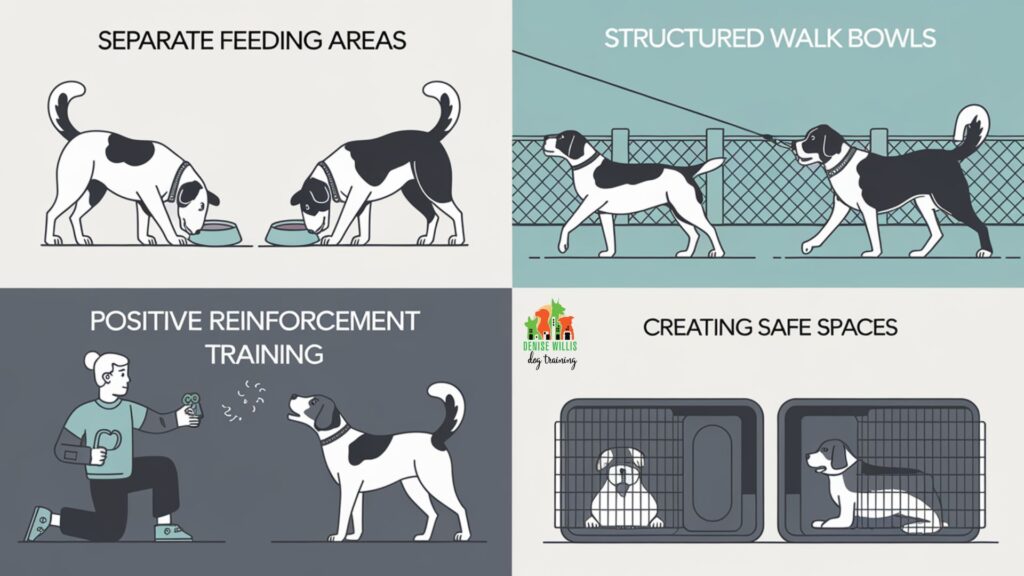
DIY Training Techniques: Empowering Owners to Address SSA
Ready to roll up your sleeves and tackle same-sex aggression head-on? These DIY techniques will have you feeling like a bonafide dog whisperer in no time.
Basic Behavior Modification Exercises
Try these at home:
- “Look at That” game for desensitization
- Parallel walking for controlled exposure
- “Find It” game to redirect focus
Creating Positive Associations Between Dogs
Turn rivals into friends with:
- Treat parties when both dogs are calm
- Shared positive experiences (car rides, walks)
- Rewarding calm behavior in each other’s presence
Establishing and Maintaining Boundaries
Set clear rules:
- Consistent commands and expectations for all dogs
- Clear “no-go” zones for each dog
- Regular training sessions to reinforce good behavior
When to Seek Professional Help: Recognizing Your Limits
Sometimes, even the most dedicated dog parent needs to call in the cavalry. Here’s how to know when it’s time to wave the white flag and seek professional reinforcements.
Signs that SSA is Beyond DIY Solutions
It’s time to call in the pros if:
- Aggression is escalating despite your efforts
- You feel unsafe managing the situation
- There’s a history of injuries from fights
Types of Professional Help Available
Options include:
- Certified Professional Dog Trainers (CPDT)
- Veterinary Behaviorists
- Applied Animal Behaviorists
What to Expect from Professional Intervention
A professional will likely:
- Conduct a thorough assessment of the situation
- Develop a tailored behavior modification plan
- Provide hands-on training and support
Remember, seeking help is a sign of strength, not failure. Your dogs (and your sanity) will thank you.
Product Recommendations
Dealing with SSA doesn’t mean you have to convert your home into Fort Knox, but a few choice products can make life easier. Here’s a roundup of items that might just save your sanity (and your furniture):
- ThunderShirt Anxiety Jacket: Is your dog auditioning for the role of “Fun Police” at the local park? Wrap them in this snug jacket and watch them transform from Captain America to Bruce Banner. Warning: May cause your dog to believe they’re being hugged by a very persistent octopus.
- PetSafe Gentle Leader Headcollar: Turn your four-legged bodyguard into a perfect gentleman with this headcollar. It’s like a steering wheel for your dog, minus the horn and airbags. Caution: Your dog may temporarily believe they’ve joined a secret dog society where everyone wears fancy face accessories.
- Outward Hound Nina Ottosson Dog Brick Puzzle Toy: Keep your canine Sherlock Holmes busy with this interactive puzzle. It’s like “Escape Room: Doggy Edition,” but with treats instead of clues. Warning: This may turn your dog into a treat-finding savant who starts solving your Sudoku puzzles.
- KONG Classic Dog Toy: The Swiss Army knife of dog toys, perfect for redirecting your pup’s protective instincts. It’s like a chew toy, puzzle, and stress ball all rolled into one rubber cone of joy. Caution: Your dog may start expecting you to stuff their entire dinner into this magical red cone.
- Zuke’s Mini Naturals Training Dog Treats: These tiny treats are perfect for rewarding good behavior. They’re like doggy cryptocurrencies – small, valuable, and your dog will do anything to get more. Caution: Your dog may start expecting these for every minor achievement, like successfully napping or heroically guarding against the evil mailman.
While these products won’t turn your protective pooch into a zen master overnight, they’ll certainly make the journey more fun.
And who knows?
With enough puzzle toys and treats, your dog might just decide that being a loving pet is a much better gig than being an overzealous bodyguard.
Further Reading
You’ve made it this far in your quest to understand the mysterious world of canine protective instincts. But why stop now? Dive deeper into the doggy psyche with these paw-some articles. Warning: Side effects may include spontaneous tail-wagging and an irresistible urge to say “Who’s a good boy?”
- 10 Warning Signs Your Dog Might Bite and How to Prevent It: Think your dog’s just smiling with extra teeth? Think again! This article decodes the secret language of canine warnings. Spoiler alert: If your dog starts speaking in Morse code, you’ve probably missed a few earlier signs.
- Decoding Your Dog: 15 Body Language Signals You Need to Know: Ever wish your dog came with subtitles? This guide is the next best thing! Learn to read your dog’s body language like a pro. Caution: This may result in you unconsciously tilting your head and wagging your behind when excited.
- How to Manage Your Dog’s Territorial Aggression: Is your dog trying to claim the entire neighborhood as their kingdom? This article helps you negotiate a peace treaty. Bonus: Includes tips on explaining property laws to your furry friend.
- 5 Proven Strategies to Stop Your Dog’s Aggression Towards Other Dogs: Transform your canine confrontationalist into a doggy diplomat with these strategies. Warning: Your dog may start organizing peace summits at the local park.
- Dog Aggression Solutions: A Complete Guide to Stopping Aggressive Behavior in Dogs: The ultimate playbook for tackling canine aggression. It’s like “The Art of War” for dog training, minus the ancient Chinese philosophy (unless your dog is into that).
These articles offer valuable insights into managing same-sex aggression in dogs. As you explore these resources, remember that every dog is unique, and it may take time to find the right approach for your situation. Your commitment to understanding and addressing this issue is a testament to your dedication as a pet owner.
Frequently Asked Questions About Same-Sex Aggression in Dogs
Q: How do I stop same-sex aggression in dogs?
A: Stopping same-sex aggression requires a multi-faceted approach. Start with behavior modification techniques like positive reinforcement and desensitization. Manage the environment to reduce triggers, and consider professional help for severe cases. Remember, consistency and patience are key. Rome wasn’t built in a day, and your dogs won’t become best buddies overnight either.
Q: How common is same-sex aggression in dogs?
A: Same-sex aggression is more common than you might think. A study found that 79% of inter-dog household aggression cases involved same-sex pairs, with 68% of those pairs being females. It’s like a canine version of “Mean Girls” out there!
Q: How do I stop aggression between two female dogs?
A: Stopping aggression between female dogs can be challenging, as it tends to be more intense than male-male aggression. Start by identifying and removing triggers, using positive reinforcement for calm behavior, and considering professional help. Remember, spaying may not significantly reduce aggression in females, so behavioral training is crucial.
Q: How do I stop inter-dog aggression towards other dogs?
A: To stop inter-dog aggression, focus on training and socialization. Teach your dog to respond to commands even when excited, use positive reinforcement for calm behavior around other dogs, and gradually expose your dog to others in controlled settings. Professional help can be invaluable in severe cases.
Q: Can same-sex aggression in dogs be cured?
A: While “cure” might be a strong word, same-sex aggression can often be managed effectively with proper training, environmental management, and sometimes professional help. Think of it less as a cure and more as teaching your dogs to be civil coworkers rather than besties.
Q: Is same-sex aggression more common in male or female dogs?
A: While both sexes can exhibit same-sex aggression, it’s often considered more severe and harder to resolve in females. However, male dogs can certainly have their fair share of testosterone-fueled disputes too.
Q: What breeds are most prone to same-sex aggression?
A: While any breed can exhibit same-sex aggression, some are more prone to it. These include Alaskan Malamutes, Dobermans, terrier breeds, Boxers, American Pit Bull Terriers, German Shepherds, and Rottweilers. But remember, individual personality matters more than breed stereotypes!
Q: Can neutering or spaying help reduce same-sex aggression?
A: Neutering can help reduce male-male aggression in some cases, but it’s not a guaranteed fix. For females, spaying typically has less effect on aggression. It’s best to combine altering with behavioral training for the best results.
Q: How do I introduce a new dog to prevent same-sex aggression?
A: When introducing a new dog, choose a neutral location, keep initial meetings short and positive, and closely monitor body language. Gradually increase interaction time and always supervise. Consider professional help for the introduction if you’re concerned about potential aggression.
Q: When should I seek professional help for same-sex aggression in my dogs?
A: If aggression is escalating despite your efforts, if you feel unsafe managing the situation, or if there’s a history of injuries from fights, it’s time to call in a professional. Remember, seeking help is a sign of responsible pet ownership, not failure!
Test Your Knowledge: Same-Sex Aggression in Dogs
Final Thoughts
Dealing with same-sex aggression in dogs can feel like you're starring in your own furry version of "Game of Thrones," minus the dragons (though sometimes you might wish for one to swoop in and sort things out). With the right approach, a dash of patience, and perhaps a sense of humor, you can navigate these choppy waters.
Remember, every dog is unique, and what works for one pair might not work for another. It's all about finding the right balance of training, management, and maybe a few well-timed treats. Don't be afraid to experiment with different techniques, and always prioritize safety for both your dogs and yourself.
If you find yourself in over your head, there's no shame in calling for backup. Professional trainers and behaviorists are like the Special Forces of the dog world. they've seen it all and have the tools to help you and your furry friends find peace.
At DW Dog Training, we understand the challenges of managing same-sex aggression. We're here to support you every step of the way, whether you need advice, training sessions, or just a sympathetic ear. Remember, you're not alone in this journey, and with the right help, even the most dramatic doggy divas can learn to coexist.
So, take a deep breath, arm yourself with knowledge (and maybe a few extra chew toys), and get ready to restore harmony to your home. Your dogs may never be best friends, but with your help, they can at least learn to be civil roommates. After all, if humans can learn to share the remote control, surely dogs can learn to share a home!
We Want to Hear From You!
Have you navigated the choppy waters of same-sex aggression with your furry friends?
We're all ears for your tales of canine conflict resolution!
Maybe you've mastered the art of peace-keeping between two feisty females, or perhaps you've become an expert in managing male dog machismo.
Whatever your experience, we want to hear about it!
Did you try any of the techniques we mentioned?
We'd love to know if they worked wonders or if they fell flat. Did your dogs suddenly decide to bury the hatchet (hopefully, not literally), or did they look at you like you were trying to teach them calculus?
Have you discovered an unconventional method that turned your doggy drama into a heartwarming sitcom?
Maybe a particular toy that became the Switzerland of your household, or a training trick that had your pups going from growls to tail wags?
Your fellow dog owners are all ears (and paws) to hear about your journey through the world of same-sex canine aggression. Your story could be the beacon of hope for someone currently feeling like they're refereeing a never-ending doggy dispute.
So, whether you're celebrating success or still in the trenches, we want to hear from you!
Drop your comments below.
Share your triumphs, your ongoing challenges, or even your humorous mishaps. (We promise not to laugh too hard if you tell us about that time you ended up wearing the water bowl while trying to separate your squabbling schnauzers.)
Remember, every experience shared is a helping hand extended to another dog owner. Your story might just be the key to unlocking harmony in someone else's home.

